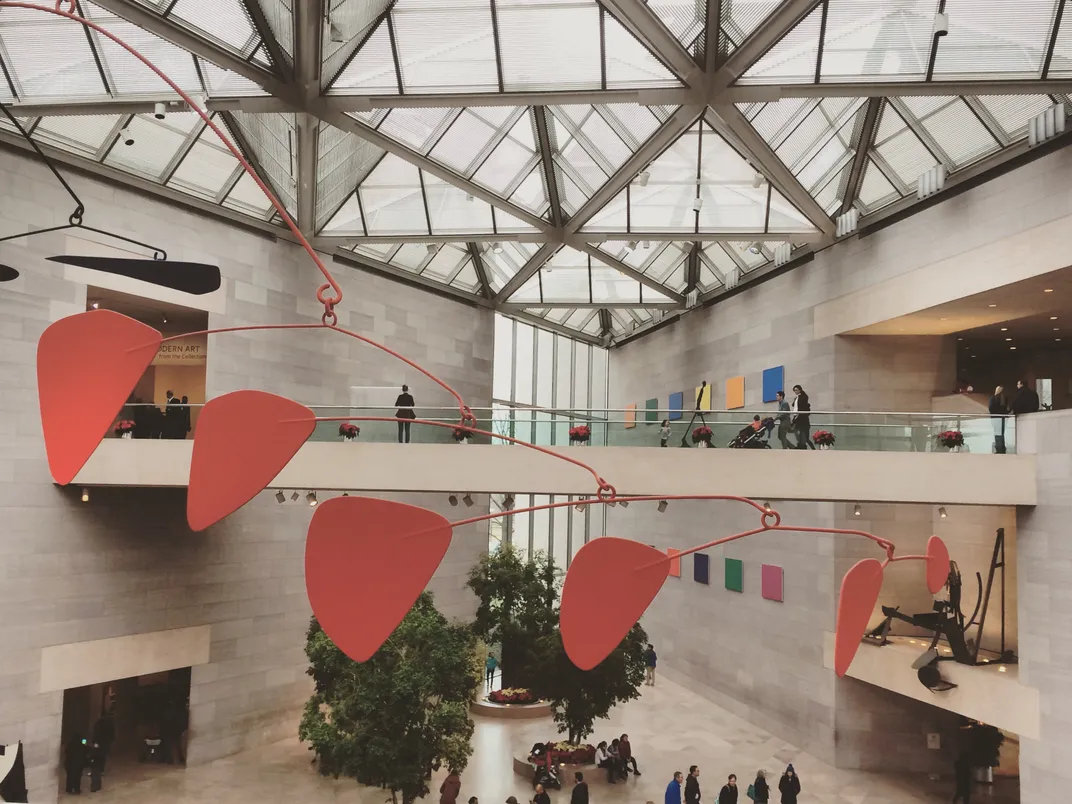Explore the Newly Digitized Archive of Alexander Calder, Famed ‘Sculptor of Air’
A new online trove from the Calder Foundation offers fans endless avenues to learn about the artist’s life and work
/https://tf-cmsv2-smithsonianmag-media.s3.amazonaws.com/filer/a1/cd/a1cdfbcc-e0bc-466f-af4a-befe8dadf1d2/gettyimages-837234868.jpg)
During his lifetime, Alexander Calder’s whimsical “mobiles,” or moving abstract sculptures that balance on thin wires and appear to float in the air, ensured his status as one of America’s most beloved sculptors.
Forty-five years after the artist’s death in 1976 at age 78, admirers can explore materials linked to his life and work through a newly debuted digital archive from the Calder Foundation. Per a statement, the regularly updated site currently features 1,377 works of art, 1,000 historical photographs and archival documents, and 48 historic and contemporary scholarly texts.
Alexander Rower, president of the foundation and the artist’s grandson, tells the Art Newspaper’s Gabriella Angeleti that the project makes his grandfather’s archive available to “thousands of people instead of dozens of people.”
Previously, a spokesperson adds, the Calder archive was restricted to scholars and curators. Due to the fragility of some of the artworks, several staff members were required to be on-call during any given visit.
“Now anyone—from someone who knows Calder’s name but not much about him, to college students to curators or scholars writing a book or planning an exhibition—can make connections that would have been impossible before,” the spokesperson tells the Art Newspaper.
/https://tf-cmsv2-smithsonianmag-media.s3.amazonaws.com/filer/2c/9c/2c9ce027-d269-4e3d-991b-787cace9af63/chicago_ill_alexander_calder__flamingo__1974_acier_4826658258.jpg)
The new platform features 43 hubs dedicated to historic exhibitions of Calder’s work, 7 image-rich timelines that examine different periods in the artist’s life, and an interactive map that displays where his works are held in collections or displayed throughout the world.
As Valentina Di Liscia reports for Hyperallergic, viewers can click through numerous examples of both Calder’s “mobiles”—kinetic sculptures activated by air currents—and “stabiles,” or stationary works often crafted out of sheet metal. Featured stabiles range from the 53-foot-tall red Flamingo (1973) in downtown Chicago to the multi-colored Grand Crinkly (1971) at the Leeum, Samsung Museum of Art in Seoul, South Korea.
Born into a family of Pennsylvania-based artists in 1898, Calder moved to Paris, where he became friends with such noted avant-garde artists as Jean Cocteau, Marcel Duchamp and Piet Mondrian, during the 1920s.
Many of his delicate early sculptures were made out of wire and drew direct inspiration from the trapeze artists and other spectacles of the circus, as biographer Jed Perl wrote in his 2017 book, Calder: The Conquest of Time.
“[T]he performances he mounted of his miniature Cirque Calder—whimsical wire figures, including a horse, acrobats and trapeze artists, placed inside a small-scale ring and animated by hand or from suspended wires by Calder himself—had been attended by a who’s who of the Parisian artistic world,” explained Perl in an excerpt of the book adapted for Smithsonian magazine.
Following a transformative visit to Mondrian’s studio in the 1930s, Calder began to shift toward abstraction in his sculptural works, per a Calder Foundation timeline. As his international fame grew, Calder began to create ever-larger monumental public works across the globe.

In addition to sculpture, Calder fostered a lifelong interest in theater set design, works on paper, and jewelry (such as this bracelet and necklace in the collections of the Smithsonian American Art Museum). Those interested in the artist’s personal life can peruse rare family photos and a 1907 self-portrait drawn with crayons when he was about 9 years old. (The drawing depicts a smiling young boy at work on a project.)
Other early works featured in the online archive include a 1909 sculpture of a dog, small ink sketches of animals and studies of trapeze artists from the early 1920s.
Art enthusiasts can compare Calder’s wire sculptures of contemporaries, including famed dancer, activist and spy Josephine Baker and tennis player Helen Wills, with later signature mobiles such as Snow Flurry (1950). Visitors can also dive into a short 1963 film from avant-garde German director Hans Richter on the sculptor’s artistic process. As the Art Newspaper reports, the short documentary will be featured in an upcoming Calder retrospective at the Museum of Modern Art in New York City.
“Our goal with this project is to offer visitors a version of the extraordinary experience I had going through my grandfather’s papers ... when building the Calder Foundation’s archive,” says Rower in a statement quoted by Pace Gallery. “I believe it will transform our understanding of his genius.”
/https://tf-cmsv2-smithsonianmag-media.s3.amazonaws.com/accounts/headshot/nora.png)
/https://tf-cmsv2-smithsonianmag-media.s3.amazonaws.com/accounts/headshot/nora.png)